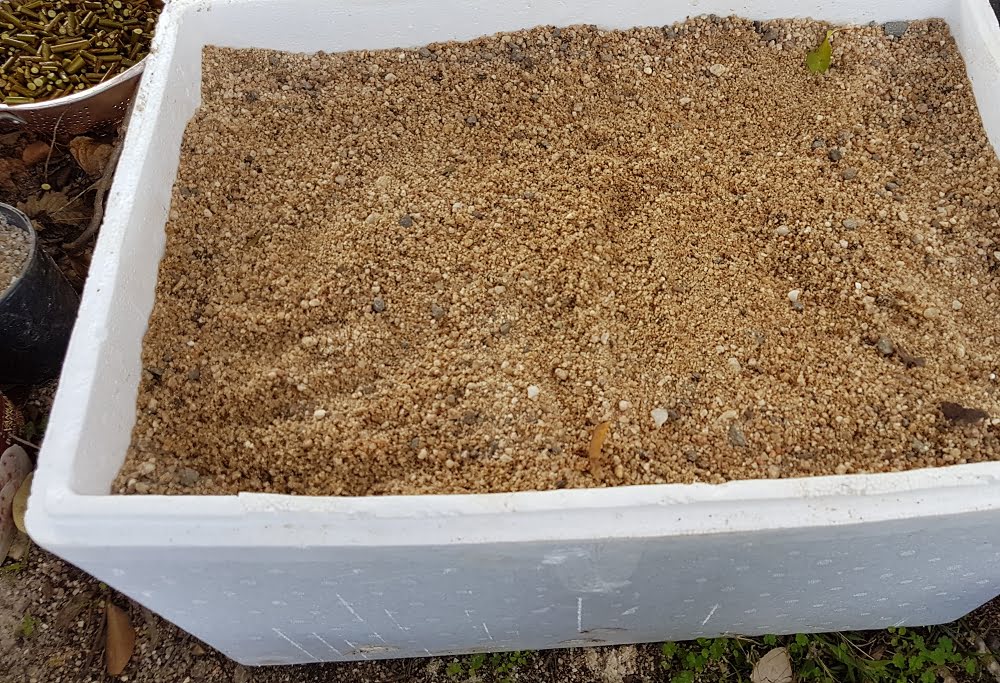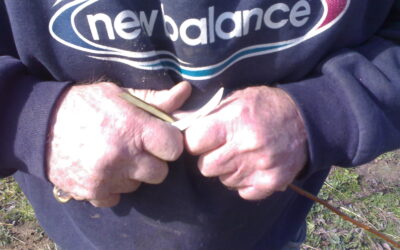Estimated reading time: 6 minutes
Ever tried growing your own fruit tree from seed? It’s fun, free, and a great activity for kids. We highly recommend that you give it a go!
The best reason to save seeds from the fruit you eat is to grow your own rootstocks for grafting, giving you strong, homegrown trees.
Seed-saving is something we do all the time at Carr’s Organic Fruit Tree Nursery (our on-farm nursery) and it’s a simple, rewarding skill you can try too!
Which fruit trees will grow from seed?
Growing rootstocks is the first step of creating your own fruit trees for free.
Peaches, nectarines, apples, pears, and quinces will all grow easily from seed. Even apricots will often sprout. We usually grow our own peach, plum, pear, and quince rootstocks in the nursery this way.
Unfortunately, cherry seeds hardly ever sprout. In the nursery, we grow them in a perennial propagation bed called a stoolbed. Plum seeds also rarely germinate, so plum trees are best grown from cuttings rather than seed.
If you’re not sure whether a seed will sprout, just try it—you’ll soon learn if it works or not.

Where to find seed to grow fruit trees
We’re lucky enough to be able to source plenty of seed directly from the farm. This is just as well because we need industrial quantities.
In recent years we’ve been hosting the Growing Abundance juice press (which in turn is on long-term loan from the generous folk at The Little Red Apple in Harcourt).
Our on-farm orchard uses it every summer to juice apple and pear seconds at the end of the season.

Being able to juice apples and pears grown here on the farm (in those years when there’s a good enough harvest) yields enough delicious organic apple juice to share around. The seed is really just a by-product.
When Ant was looking after the orchard, he even made enough juice to turn into cider. Cider is a step further than juice-making but definitely one of those forgotten skills that’s worth reviving.
If you’re just growing rootstocks for yourself at home, you don’t need to go to these lengths of course. Saving the seed from a single apple may be enough.

Why fruit trees grown from seed need to be grafted
Growing trees from seed means they don’t grow “true to type”. This means that the apples the tree grows won’t be the same as the apple the seed came from.
This is because the fruit they’re growing from was usually pollinised by a different variety. The seed is a genetic mix of both its parents (just like people!).
So, you can’t grow a Pink Lady tree from a Pink Lady apple seed. But you can still use the seed to grow a tree, which is called a seedling, or a rootstock.
This can then be used as a base to graft a known fruit variety onto. If you have access to a Pink Lady apple tree, harvest some scion wood from it and your seedling becomes a Pink Lady apple tree once again!

When should you plant fruit tree seed?
Growing rootstocks for grafting involves a few small jobs at different times of year, just like all gardening really. There’s a full grafting calendar in our Grow Your Own Fruit Trees for Free course, but here are a few seasonal jobs:
- Late summer – gather peach and nectarine seeds, store them in damp sand
- Autumn – gather seeds from apples and pears, store in damp sand
- Winter – gather scion wood from varieties you want to use for grafting in spring and store it correctly to keep it in good condition.
- Winter – gather plum cuttings and store them in damp sand
- Spring – plant seeds and cuttings in a pot or the ground

Does it sound complicated? It’s really not.
Grafting is an ancient method of preserving heritage fruit varieties that has been practised for hundreds of years, and continues to be passed from fruitgrower to fruitgrower today.

We think teaching people how to grow their own fruit trees from scratch is one of the most important skills we teach (through our grafting courses).
If you can grow your own fruit trees, you’ve got true fruit security.
Related Articles
A good grafting knife…
A good grafting knife (and knowing how to keep it sharp) sets you up for grafting success as much as the techniques you need to master.
How to grow your own multigraft or fruit salad tree
Multigraft trees are a no-brainer for many gardens, as they reduce risk and provide a bigger variety of fruit, without taking up more space.
The joy of growing your own fruit trees
Growing your own fruit trees is a wonderful life-long hobby, but if you can’t grow your own, try to buy from a local nursery.








Good morning. I understand that growing from seed won’t give me a true-to-type quality, but l would have thought cuttings would give the desired result, much like grafting? Why would a cutting not give the same result as a scion grafted? Hope you can explain to help me understand. Kind regards, Peter
Cuttings will produce a plant that is true-to-type as it is a form of vegetative propagation. Seedling rootstocks have strong root systems and tend to be fairly vigorous resulting in a large tree that is slower to produce fruit than some of the smaller dwarfing rootstocks available for commercial production these days. Trees on seedling rootstocks also have a longer lifespan than modern dwarfing and semi-dwarfing rootstocks, but are usually less precocious and slower to produce fruit. Some rootstocks have a tendency to sucker and these suckers can be cut from the parent plant to produce true-to-type rootstocks, which can then be grown on and grafted with the desired scion cultivar. Commercially, rootstocks are produced by layering which produces a true-to-type rootstock. Many commercial rootstocks are grown because of their size restriction characteristics and/or disease/pest resistance.
Hope this helps, Sally
Thanks Sally for your input – that’s a great summary of rootstocks!
Hi Peter, you’re right – a cutting will produce a ‘true to type’ tree, but there’s a couple of reasons we don’t usually do this. For example, not all cuttings will take (whereas seedling rootstocks are more reliable), and also the variety (e.g. Golden Delicious) may not make a good rootstock tree (rootstocks are chosen for various characteristics such as size, disease resistance etc. – and the variety may not have characteristics that you want in your tree if you grow it on its own roots). Having said all that, there’s absolutely no reason not to try it yourself at home. One of the fantastic things about growing your own fruit trees and grafting is that you can experiment endlessly, for basically zero outlay. Let us know how it turns out!
I’m in Hunter Valley, thank you.
I just have lemon orange and mulberry little trees I think in pots as I have very hard clay soil. I don’t want huge trees or having roots destroying house.
I have 2 only lemons ripening or oranges. I think lemons not much fruit I know but something.
Want to grow veges so need to get more plants. Managed to grow cucumbers and trying to grow garlic and ginger, potatoes. Sweet potatoes. Want to grow other veges too.
So very windy here and still very cold 30C at night and very cold during the day.
No early reprieve from winter here
Bbbbrŕr!!!!
Christine
Hi Christine, it sounds like you’ve got the beginnings of a great garden there! It’s possible to improve any soil – even hard clay. The trick is adding lots of organic matter (like good quality compost, for example). Best of luck with your growing.
Highly recommend growing perennials! Much less work and so much better for the soil/ whole ecosystem. I practise permaculture/am creating a food forest and will never go back 🙂
I’m obliged for the post. Really looking forward to read more. can i share this ?
Hi Adi, glad you’ve enjoyed the post, and thanks for checking whether it’s OK to share. Yes it is, please credit us, and we’d appreciate a link back to this website as well. Thanks!
Hello,I have a small custard apple plant that has come up from a seed dropped by birds I assume. Can I graft a piece of the mother tree to that little one when it gets a bit bigger?? Will it be true to type if I do it successfully. Also if I just let the seedling grow , how long would it take to fruit??
Hi Ivy, yes you can graft the original tree onto the seedling, then it will produce fruit that is the same as the parent tree, i.e. true to type. If you leave the seedling ungrafted, it may also produce edible fruit, but it won’t be the same as the parent. It might produce fruit quite quickly left to its own devices, but we always recommend not letting a young tree have fruit for the first 3 years or so, while you prune it into the right shape, as we describe in this short course: https://growgreatfruit.com/product/pruning-young-fruit-trees/)
Karen Witek from hunter valley
I have just been reading about saving the seeds from peach nectarine etc i have got that part but can you use shop bought fruit seeds or are the no good and then if they are then where do you get the grafted stock from do i go to the nursery and take a cutting (i gues not) i bought a grafted peach/nectarine this year and they said for the first year dont let it fruit so i have done that but i would like to graft more as i only have a small yard but i do have a few trees but would like to build it up with a few more
Hi Karen, yes shop-bought peaches and nectarines are completely fine to save the seed from. The best grafting technique for peaches and nectarines is summer bud-grafting, which is fully described (with videos) in this short course: https://growgreatfruit.com/product/grafting-technique-4-summer-grafting-budding/. You can either buy the grafting wood (called ‘scion’) or better yet, get it for free from a friend or neighbour’s tree, or join your local gardening group (or even a local gardening group on social media). Nurseries don’t usually take too kindly to public pruning of their trees! Good luck with expanding your fruit tree selection, it’s really pretty easy to do, so we’d encourage you to give it a go and learn more about it.
How do you choose scion trees?
Hi Teri, well there are a few things to consider – one is the kind of root stock you’ve got (root stock & scion wood generally need to be from the same genus). And then, really, the world is your oyster – consider what you like to eat, what might grow well in your conditions, fruiting timing in relation to other trees, and maybe even consider multi-grafts. Take a look at some of our blogs & short courses on grafting and that will be a good start to help you work out your choices :). Good luck, Meg – GGF team.